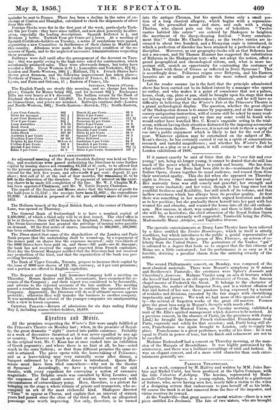it4tatr9 au t(
All the promises respecting the Winter's Tale were amply fulfilled at the Princess's Theatre on Monday last ; when, in the presence of Royal- ty, the great dramatic "sight" started into public existence. Probably as a work of decorative theatrical art it was never equalled in any age or country. Wherever so much as a hint at classical antiquity is given in the original text, Mr. C. Kean has at once rushed into an exhibition of Greek pageantry ; and where there is no hint at all, he has—acted much in the same fashion; so that from different premises the same re- sult is attained. The piece opens with the leave-taking of Polixenes ; and as . a leave-taking may very naturally: occur after dinner, a banquet enlivened by a Pyrrhic dance is Introduced. Queen Her- mione must have been tried somewhere—why not in the theatre at Syracuse ? Accordingly, we have a reproduction of the said theatre, with every expedient for conveying a notion of extensive magnitude. The Delphic oracle was consulted by King Leontes ; and the responses of that occult source of wisdom were conveyed with circumstances of extraordinary pomp. Here' therefore is a pretext for bringing on the stage a whole retinue of priests and trumpeters, who ac- company an ark of the most recherché kind. Shakspere directed " Time ' to appear as Chorus, and explain that an interval of sixteen years had passed since the close of the third act. Such an allegorical personage was worth improving. Not only, therefore, is he turned into the antique Chronos, but his speech forms only a small por- tion of a long classical allegory, which begins with a representa- tion of the personified moon and stars, and ends with a riling Phcebus, who almost puts out the eyes of beholders. "Twelve rustics habited like satyrs" are ordered by Shakspere to heighten the merriment of the sheep-shearing festival. " Sorry . entertain- ment this ! " thinks Mr. Charles Keen; so the twelve rustics are in- creased to about two hundred, and a Dionysian orgie is introduced, in which a perfection of disorder has been attained by a perfection of stage- discipline. Moreover, as our geography-books tell us that Bohemia has not a sea-coast, and Sir Thomas Hammer has suggested the substitution of Bithynia in the Shaksperian text—why not adopt the notion, effect a grand geographical and chronological reform, and, what is more im- portant still, snatch an opportunity for contrasting the costumes of Asia Minor with those of Greece as reflected in Doric Syracuse ? This is accordingly done. Polixenes reigns over Bithynia, and his Eastern luxuries are as unlike as possible to the more refined splendour of Leontes.
Let the reader assume (as is the fact) that the principle adumbrated above has been carried out to its fullest extent by a manager who spares no outlay, and who makes it a point of conscience that not a palace, house, cloak, cap, plate or pan, shall be brought upon his stage that does not belong to the period he undertakes to illustrate, and he will have no difficulty in believing that the Winter's Tale at the Princess's Theatre is a grand archeological display. The question, whether the groat object of the Shaksperian drama is to amuse by pageantry, and at the same tame convey antiquarian instruction, will of course still be asked by many read- ers of our national poetry; and we dare say some could be found who would rather have watched Mrs. C. Kean's exquisite acting in the trial- scene, without having their attention distracted by the imposing accessories of the Syracusan theatre. However, it is not our wish to throw a sprig of rue into a public enjoyment which is likely to last for the rest of the Tear. Whatever opinion may be entertained on the subject of Mr. Kean's theory, he has certainly carried it out in a spirit of conscientious research and tasteful magnificence ; and whether his Winter's Tale be witnessed as a play or as a pageant, it will certainly be one of the chief London exhibitions of 1866.






































 Previous page
Previous page